Blog
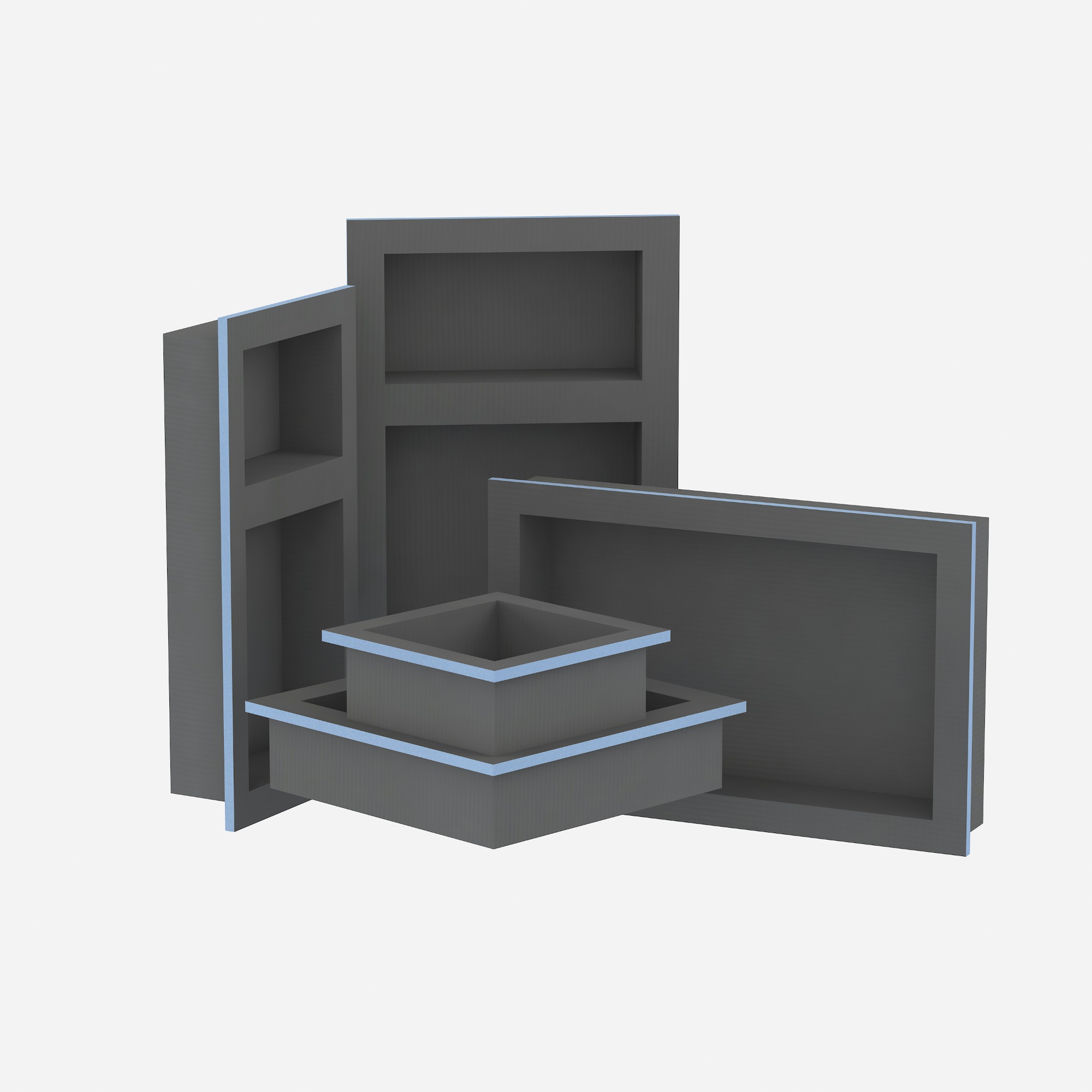
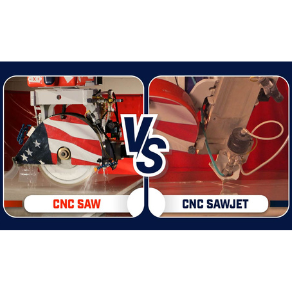
CNC Vs. Sawjet: Which is Best for Your Shop?
CNC Vs. Sawjet: Which is Best for Your Shop?
When deciding on machinery to add to your shop, consider the capabilities of both a CNC saw and CNC sawjet before making a final decision
.jpg?1653980594)
Photo courtesy of Park Industries
Stone fabricators rely heavily on machines to meet their customers’ needs. Selecting the right equipment is crucial for shops, whether they are just starting out or looking to upgrade from existing machines.
A hot discussion among stone fabricators is which machine is better…a CNC saw or a CNC sawjet? And the answer is…it depends. Both machines offer a ton of production capabilities, but what is right for you depends on your situation.
To help you make the best decision for your shop, we will explain the key differences and strengths of each machine type and compare CNC saws vs sawjets.
What is a CNC Saw?
The basics: a CNC saw allows fabricators to program a layout and let the saw cut it out automatically using computer numerical controls (CNC). Stone cutting CNC saws are a popular choice for countertop fabrication and can perform cuts cleanly, quickly and efficiently.
A CNC saw, especially a 5-axis one, utilizes its blade for straight cuts, miter cuts, straight line profiling and even some arc cuts. For sinks, faucet holes and radius parts, it uses tools and bits with its spindle.
With these milling capabilities and innovative features, CNC saws can perform nearly any cut and offer tight nesting. They are an excellent choice for your first CNC machine or when upgrading from a bridge saw, as they also offer manual cutting capabilities.
What is a CNC Sawjet?
You can think of a CNC sawjet as an upgraded version of a CNC saw. Both use a saw blade for straight and miter cuts, but instead of using a tool bit for sinks, tight nesting and radius cuts, a sawjet uses its precision waterjet. This is the key difference between sawjets and saws. The waterjet cuts faster, tighter and with more precision than a tool.
CNC sawjets, are typically considered the “crème de la crème” when evaluating cutting solutions. They offer the highest level of production, and with that, are a higher initial investment than a CNC saw.
With the waterjet’s ability to make any cut without worry of running into parts, CNC sawjets allow for faster finishing on CNC routers or significantly less hand fabrication. Sinks are the number one time saver on a sawjet. A sawjet can enable a shop to take on more jobs, including large commercial projects or complex custom projects, thanks to its waterjet capabilities.
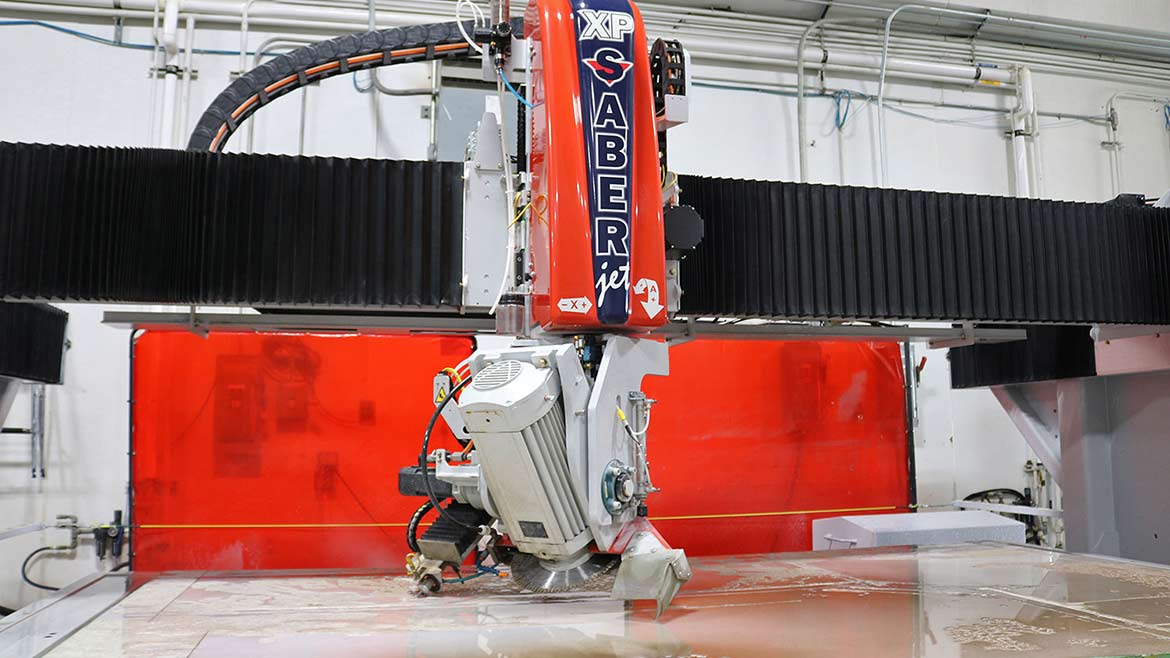
CNC sawjets offer the highest level of production, and with that, are a higher initial investment than a CNC saw. Photo courtesy of Park Industries
Comparing Your Options
You know you want to cut with a CNC machine… now the question is which one?
Both machines offer excellent blade cutting, are extremely accurate and slice through a variety of materials like quartz, granite, quartzite, porcelain and more. The key differences in performance are production speed and material yield. These really come down to tool versus waterjet. See why in the example below.
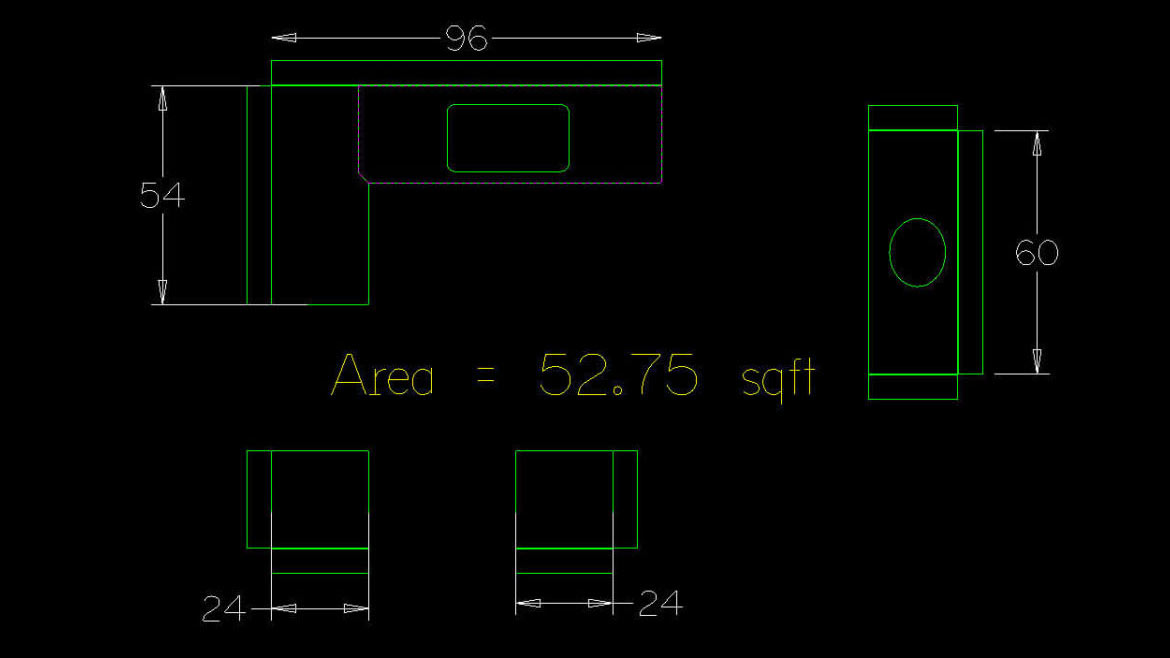
Example A: Common Kitchen Layout (52.5 Square Feet) Photo courtesy of Park Industries
Example A Scenario: CNC Saw
A CNC Saw cuts this example well, but the multiple sinks and tight nests increase its time to about 58 minutes and require two slabs. Here’s a preview of what the CNC saw program might look like, with two slabs needed.
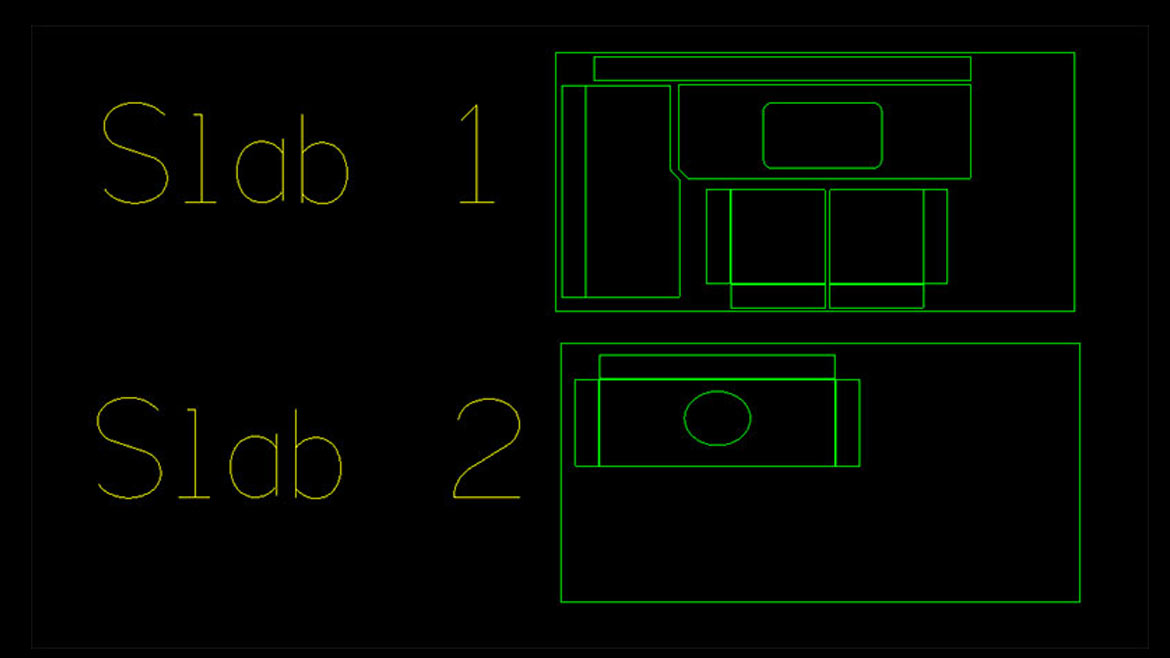
CNC saw programs for Example A Photo courtesy of Park Industries
Example A Scenario: CNC Sawjet
A CNC sawjet allows you to breeze through this example, cut this program in about 25 minutes and needing only one slab. Below is a preview of what the program of a CNC sawjet might look like, tightly fit onto one slab.
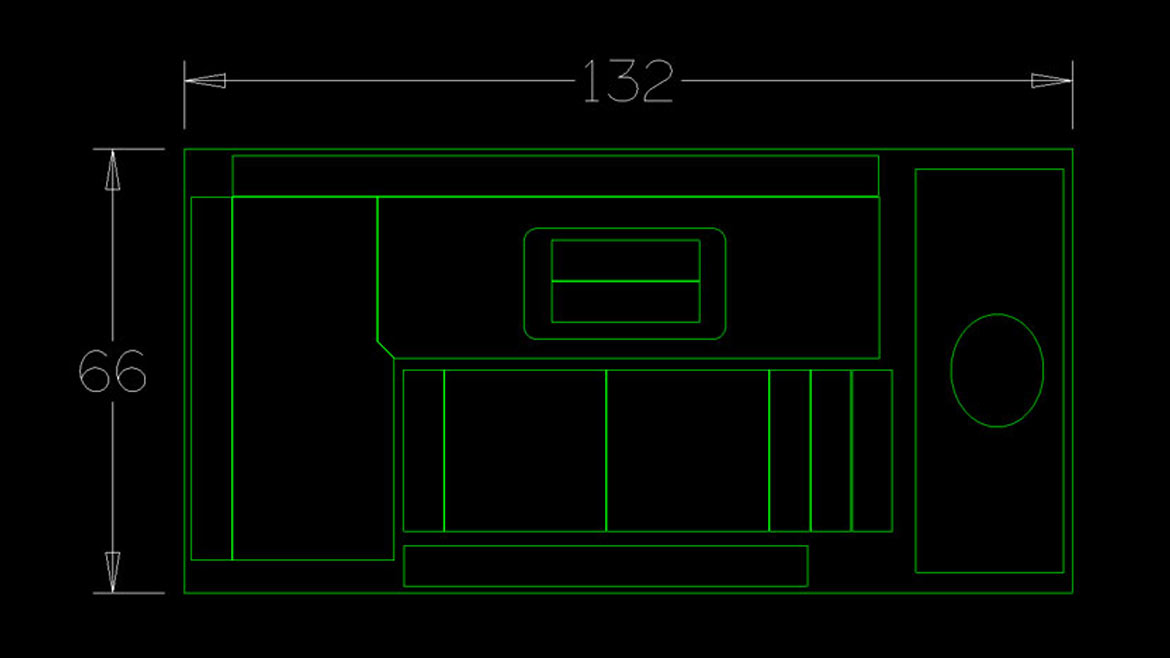
CNC sawjet programs for Example A Photo courtesy of Park Industries
Investment
With an example like this, you may be thinking to yourself, why wouldn’t you choose a CNC saw? The CNC saw has one distinct advantage over a sawjet -- cost. A CNC saw comes in at nearly half of the monthly payment, along with less operational cost and consumables due to no waterjet system. A CNC saw may be a better option for shops that need lower initial investment and want to keep things simpler.
Saw vs Sawjet: Verdict
Most fabricators would agree that a sawjet is the higher production choice. If upfront cost is not a factor and you have the demand to warrant a sawjet, you can be confident choosing this option. Factoring in materials and labor saved with a sawjet, it offers excellent return on investment (ROI).
However, if you are new to these digital fabrications, still use stick templates or only produce a handful of kitchens a week, a CNC saw will offer plenty of cutting production and easily meet your needs. The best way to determine your needs is by answering a few key questions:
- How much money can you save in labor with a sawjet?
- How much money can you save on materials with tighter nesting?
- Does your chosen solution allow for growth?
After answering these questions, you will need to determine if the sum of these savings offset the added cost of a sawjet. If you are still undecided, the best thing to do is consult an expert.
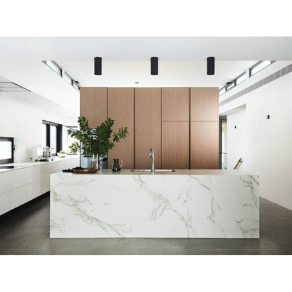
Countertops and Beyond: Three Trends in Engineered Stone
Flow Waterjet provides insight about the popularity of alternative stone options, such as quartz surfacing, and how a waterjet is ideal for cutting these materials.
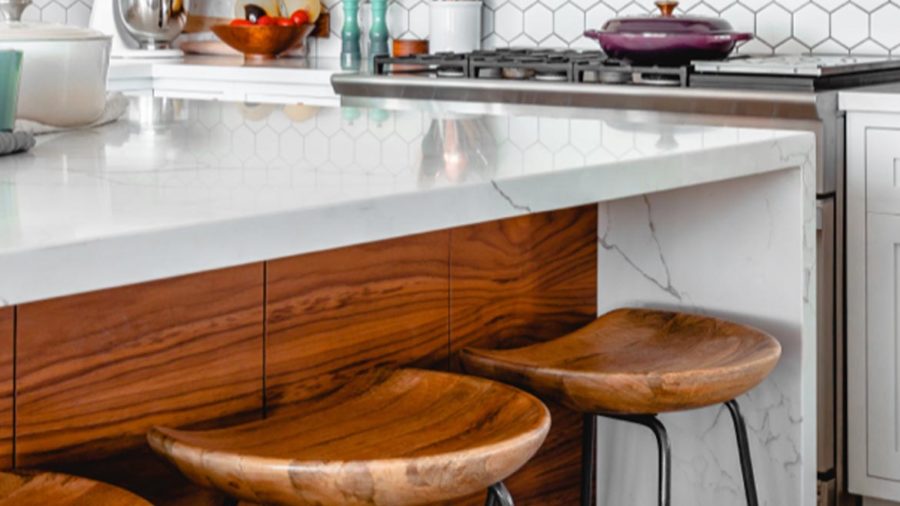
Photo courtesy of Flow Waterjet
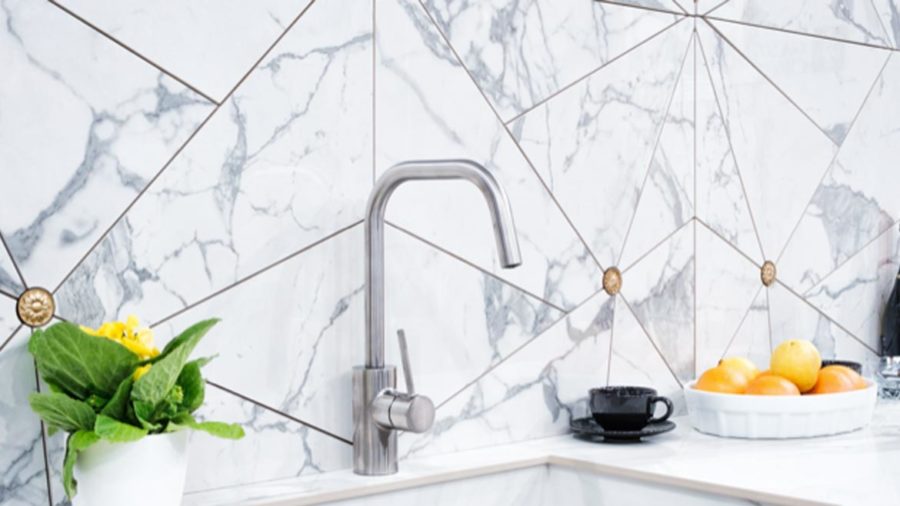
Engineered stone is a sought-after material. Its durable and eye-catching design makes it popular for kitchen countertops, floors and more. Engineered stone is often less expensive than natural stone and, as the name suggests, “engineered” to the customer’s liking – meaning nonporous slabs that are consistent in shape and color.
And the market continues to evolve, with new trends popping up as others die out. Granite is no longer the stone du jour and consumers’ desire for customizable finishes is constantly changing.
Here are three trends we are seeing in engineered stone – and how waterjet’s versatility can bring them to life.
Quartz Reigns Supreme
In recent years, it seems that quartz is the new go-to for kitchen countertops. Thanks to its non-porous surface, quartz is easy to clean and provides uniformity in color and texture. It also allows many options for buyers when it comes to design and shape. Engineered quartz contains roughly 90 percent of quartz rock itself, while the rest of the material is made up of different pigments and resins.
But it’s not just its aesthetic options that make engineered quartz popular. The material is also heat resistant and extremely durable, able to withstand acidic substances and the day-to-day work that’s done in the kitchen.
Like quartz, Dekton is another favorite among engineered stone. Dekton is created through a process that exposes the materials’ particles to extreme heat and pressure – simulating the transformation that natural stone goes through over thousands of years. Dekton’s durability and style make it a popular material for kitchen countertops and islands.
Where Does Waterjet Fit in to the Mix?
Waterjet’s versatility allows it to cut natural or engineered stone with precision. Abrasive waterjet technology can effectively cut through stone and requires minimal finishing. It’s also a great option due to its ability to make intricate cuts for those looking to create complicated inlays or edges.
Getting the Edge
When preparing a custom countertop, choosing your material is the first step. From there, it’s time to decide on a finish. Countertops, vanities and other surfaces come in a variety of shapes and sizes. They also pose the question: What kind of edge do you want?
Waterfall edges are on-trend, offering an updated look that can make any kitchen pop. These edges extend beyond the top of a surface and continue down the side of a countertop. The name comes from the idea that the material “falls” beyond the countertop and onto the floor. They’re also known as mitered edges, which consist of two slabs cut at 45 degrees that meet at a 90-degree angle.
With cutting technology like the Pivot+ cutting head, waterjet is ideal for creating beveled or mitered edges for countertops and allows you to get the job done fast with no chipping or breakage and with minimal kerf.
Beyond Countertops
While countertops are a popular application for engineered stone, there’s a lot more you can create with quartz or other synthetic materials. Flooring, shelves, mantles and shower backsplashes are all potential projects.
Quartz and other synthetic stone can also be used as an inlay on various surfaces, adding a sleek pop of design. The popularity of engineered stone will continue to grow – and its durability and color options make it an even more attractive option for interior decorating.
Engineered stone floors, for example, can withstand a lot – they are hard to chip or stain and require little maintenance. They also nicely complement quartz countertops or tables.
Abrasive waterjet doesn’t produce any heat or surface stress on engineered stone finishes, making it a great tool for a variety of projects. Waterjet’s omnidirectional cutting allows users to create intricate inlays and designs, too. No matter the application, waterjet’s adaptability can get just about any stone-cutting job done with precision.
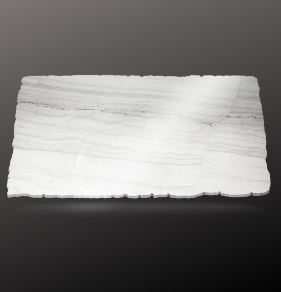
Engineered VS Natural Stone
Is My Countertop Natural or Engineered Stone?
To understand the answer to this question we will discuss the characteristics of each material.
Engineered Stone Explained
Engineered stone by definition is a composite material made of crushed stone bound together by an adhesive. For kitchen and bathroom countertops, the most common engineered stone is quartz bound together with a polymer resin adhesive. This product is commonly known as "quartz surface" or just "quartz".
Typically engineered stone will consist of 93% stone and 7% polymer resin by weight. Historically engineered stone has always been a more consistent pattern and color, but within the last few years the quartz slab manufacturers have been producing more “natural looking” colors and patterns.
Engineered stone is typically less porous and more structurally flexible than natural stone due to the polymer resin adhesive and the engineering process. The quartz in the engineered stone is very hard and resistant to scratching although the polymer resin adhesives are not UV stable and therefore should not be used outdoors or in direct sunlight as this can cause discoloration and fading issues. Engineered stone is heat and stain resistant as well.
The "Nature" of Natural Stone
Natural stone is quarried from the earth and comes the way nature has created it over millions of years. Every piece is natural and unique. The most commonly used natural stones for countertops are granite and marble along with travertines, limestones, soapstone and many others rounding out the balance. The type of natural stone that is selected will determine its hardness, porosity, coloring and pattern. Because natural stone is a product of the earth there are virtually unlimited choices of colors and patterns to choose from. No two pieces of natural stone are alike giving it uniqueness in color, movement and depth.
Granite and marble are the most common natural stones used for kitchen and bathroom countertops. Granite is very hard and resistant to scratching while marble is softer and more susceptible to scratching and etching. Granite and marble are highly heat resistant making it very difficult to damage with hot pots and pans. Natural stone is a porous product of the earth often times requiring sealers to make them stain resistant.
Determining Which Stone You Have
With so many variations in both natural and engineered stone, often it does require a stone professional to help determine the answer. Many times this is possible thru a picture. Therefore, with both engineered stone and natural stone being used for countertop surfaces it is very important to know which product you have to know the proper care and maintenance so you can enjoy the lifetime of beauty they all have to offer.
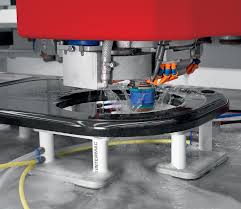
CNC Machines
Computer Numerical Control (CNC) technology has made its mark on stone design and fabrication, providing numerous benefits to those who take advantage of its capabilities. With computers controlling the machines, stone fabricators produce intricate inspiring creations with exact precision once thought impossible or too costly to achieve. As a result, architects and designers are expanding their creative limits and experiencing many benefits, including:
- Increased freedom of design
- Control of the design concept from development through fabrication
- Quality control
- Accuracy of stone shaping and the final fit and finish
Despite CNC’s benefits, many design professionals hold misperceptions about the process. Chief among the misconceptions is that CNC is only used for granite slabs. It’s often difficult to imagine a computer-controlled machine handling a large block of stone and producing the result of a finely trained sculptor with a chisel in hand. Quite the opposite, CNC machines can accept both slabs and cubic stones of all sizes with ease, depending on the type of machine the fabricator chooses. Not all fabricators with CNC capability will have the machine capacity to manufacture cubic shapes. Another misperception is that the CNC process isn’t budget friendly. Although CNC technology is advanced, it’s not cost-prohibitive. Historically, large-profiled stone components and cubic free-form shapes were labor intensive to produce. Today’s designs, in most cases, begin as a digital project in one of the many CAD or digital design tool software packages. Using this “master model” format, the fabricator realizes lower costs since much of the drafting work required for the old manual method is eliminated. What’s more, CNC achieves a very fine tolerance, reducing the need for multiple or follow-up processes. Fabrication and lead time are reduced and custom designs are easier on the budget. Realizing CNC benefits to projects, designers are choosing the technology for many high-profile projects across the country. From East to West Coast, these projects showcase examples of intricate stonework, shaped with precision.
CNC simplifies complex paver project
CNC technology played an essential role in the redesign of a key landmark in Philadelphia’s Center City District. The aging Dilworth Plaza received a new look — featuring nearly 100,000 square feet of beautiful, finely carved and crafted masonry. The result is a vibrant, open civic space for Philadelphians and visitors to enjoy, appropriately renamed Dilworth Park due to its key feature — 7,000 square feet of green space. The granite masonry used throughout the park’s exterior includes paving, walls and benches fabricated with CNC technology. The 14 large curvilinear benches along the plaza area are constructed of granite veneer and capstones of solid granite. In total, 6,500 square feet of Woodbury granite was used for the benches. According to the design team, the benches and their smooth curvilinear forms are designed to respond to the changes in grade upon entering the plaza. CNC technology made it possible to use the same files from design through fabrication, which eliminated the need to re-work each piece – saving time and reducing the potential for errors. Installation of the pavers proved complicated because of the stone’s location on top of the city’s transportation system. Essentially, the park is a roof and is in a nearly completely flat elevation. Designers had to determine the best way to channel storm water from one end of the park to the other. As such, the stonework had to maintain sufficient tolerance to achieve the required drainage characteristics. Exceptional fabrication with CNC technology achieved the accurately shaped stones meeting the specifications needed for drainage.
Precisely crafted gathering location
Farther south along the East Coast, the Smithsonian Institution’s new National Museum of African American Culture and History (NMAACH) relied on CNC technology to produce beautiful stone elements for its landscape design. Located on a 5-acre site on the National Mall between the National Museum of American History and the Washington Monument, the NMAACH is the only museum dedicated to documenting the history, life and culture of African Americans. As such, the museum features a distinguished design among the National Mall structures – in both structure and landscape. According to the landscape architecture firm for the project, the landscape is “designed to encourage visitors to extend the museum experience outside and to linger and reflect on the important narratives being told within.” To encourage visitors to extend their experience outside, a granite wall encompassing the site’s perimeter was constructed, and this perimeter wall has become a popular gathering spot on the National Mall. CNC technology was essential for creating the intricately crafted cubic wall of Mesabi Black® granite encompassing the site’s perimeter. Most of the walls feature a highly polished finish. However, a combination of polish coping and Diamond® 8 facing was selected for the museum’s north wall, which serves as the museum’s main entrance. The north wall spans approximately 340 feet across the front of the museum, running parallel to Constitution Avenue. The less reflective Diamond 8 finish was selected due to concerns over too much reflection off the wall at the highly traveled entrance. Fabrication of the granite pieces for the north wall proved particularly challenging because of the wall’s slight radius and continuous bullnose. The fabricator had to produce each of these stones at precisely the same thickness to ensure an exact alignment at installation, and CNC proved essential to the process. The fabricator also used its CNC machine to mill the wall’s cap pieces and then finished them by hand to create the bullnose. With multiple workers applying a bullnose to hundreds of pieces, accomplishing the precision required for alignment requires an exceptional level of coordination and craftsmanship. In total, approximately 37,000 square feet of granite was used for the NMAACH landscape, including the wall facing and coping, paving, steps, curbs, benches and bollards. Many of the stones for the project were modeled in 3D software, which allowed the fabricator to coordinate with the landscape architect and ensure the designs met expectations. Due to the project’s complex nature, an extensive amount of coordination between the fabricator’s drafting team and the architect ensured the 3D models were accurate prior to fabrication. Once the design team approved the fabricator’s drawings and models, the fabricator converted the models into a file for use on a 5-axis CNC machine.
Artistic sculptural element
Across the country on the West Coast, the Riverside Roundabout in Los Angeles is the city’s first modern roundabout, created to help control smog and exhaust impacts on surrounding residents. The roundabout’s centerpiece relied on CNC technology for the production of a striking sculptural element. Designed by Greenmeme Art & Design Studio, nine egg-shaped stone sculptures constructed of Academy Black® granite from California provide an artistic element to the typical concrete and asphalt urban experience. The sculptures measure 8 to 12 feet tall and feature the faces of individuals from the community. A significant amount of coordination between the architect and granite supplier and fabricator ensured the artistic vision came to life. The granite fabricator and supplier used the designer’s electronic files to create the cutting information needed to fabricate the sculptural pieces. Greenmeme’s detailed drawings provided piece-numbered assembled egg sculptures. Each piece was laid out in slab form per the design. The granite supplier selected and cut the slabs with CNC cutting equipment to provide full utilization of the slab. Sculpture pieces were then epoxied together per the design drawings. Cleveland Marble of Los Angeles was the installer on the project. The roundabout also serves as a storm water bioretention landscape, with the capacity to capture and treat a 10-year rainfall event (500,000 gallons) off an adjacent bridge and roads. The system also includes a 25,000-gallon cistern supplying a water feature, as well as a solar tracking photovoltaic system powering irrigation, lighting and the artwork. A 100% sustainable project, all parts of the granite slabs were used to create the eggs, with the remaining parts of the slab creating a stone border around the roundabout.
Communication is key
No matter the type of CNC project, careful coordination and communication between the fabricator and the team realize the vision and intent of the design. The architect’s early involvement with the stone fabricator helps ensure a successful outcome for a CNC project. The fabricator and designers should be sure to discuss stone sizing limitations due to material selection. In addition, the team should address the equipment’s work envelope and what sizes the machines can process. The ability to work together to resolve any issues will ensure the overall design concept is met. With CNC fabrication gaining acceptance across the country, use of the technology is only expected to increase in coming years. The result will allow manufacturers to produce more efficient, precise and creative designs for a new era in stone fabrication.

